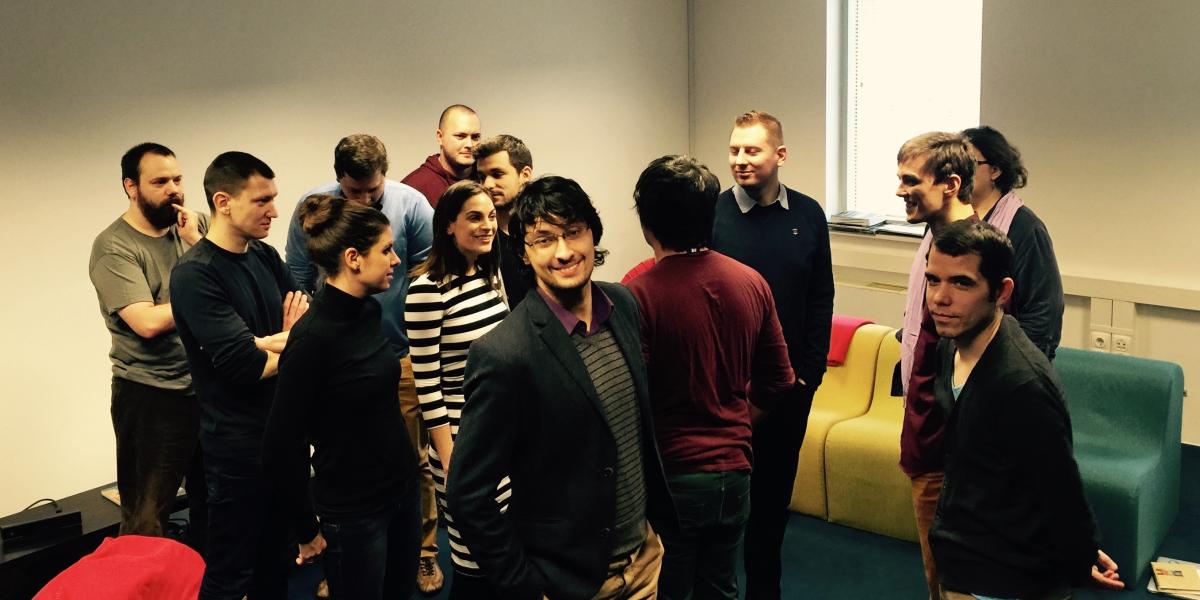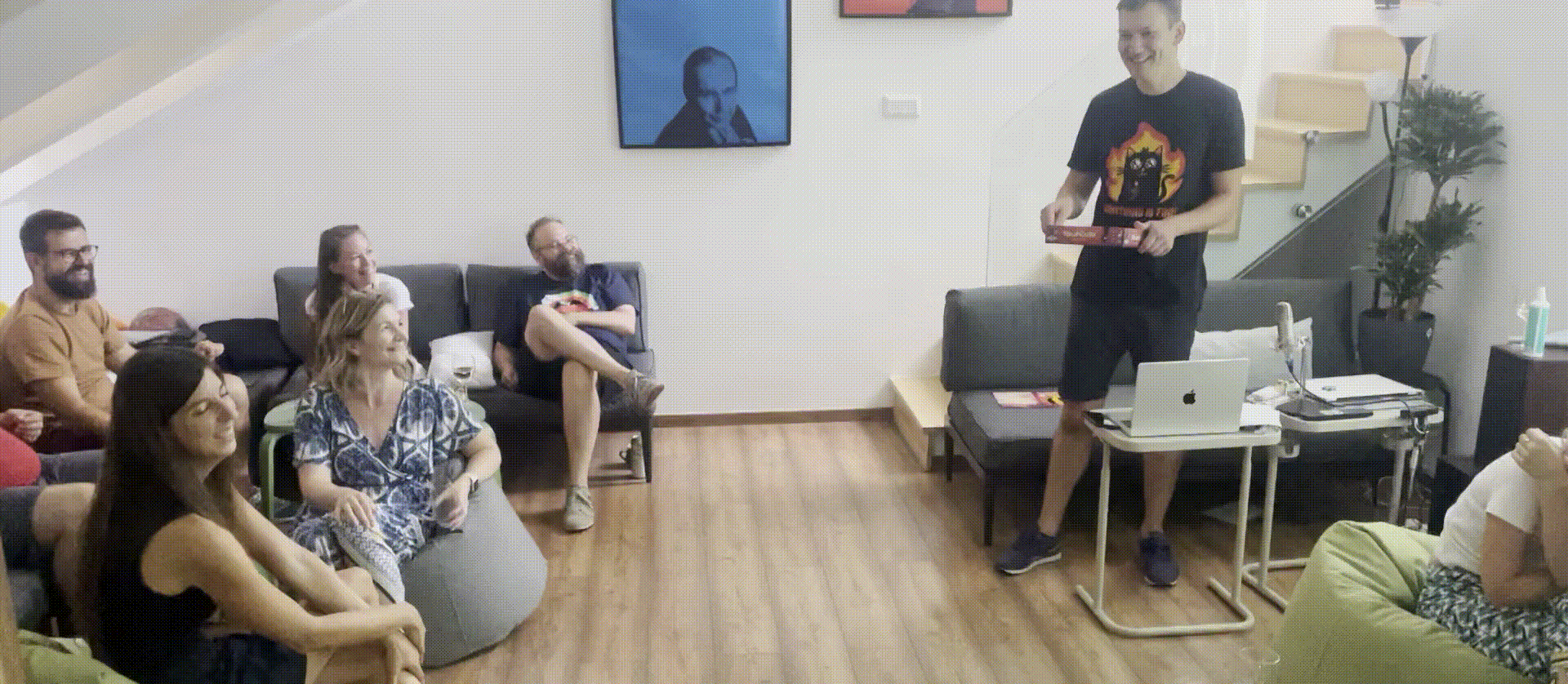
Organizational culture is the same for an organization as personality is for people.
Emese found us with the idea of being part of doctoral research analyzing agile methodology. How does agile collaboration affect personality? What is our current company culture like, and how do we see ourselves in 5 years?
She offered to prepare a report about our company if most of us complete the survey. We did this, and she drew the team on exciting graphs, compare us with other Hungarian companies that she had analyzed, and showed our focus is on organizational culture.

Below I am asking Emese about the different stages of the research and her impression based on data collected so far.
Zsolt Kulcsar: how did you get the idea to write your dissertation about agile methodology and company culture?
Emese Sándor-Dobos: I chose this topic based on personal experience, as I worked at IT companies for the past years. I noticed that some people are feeling better than others. Despite the same environment, team, and working schedule, I got curious about these differences. It was also interesting to see how company culture influences the framework into practice, how agile methodology is adopted, and what people think about it. Having discussed this with several colleagues and professionals, I got the impression that I thought it could be worth analyzing under academic circumstances, so I decided to answer these questions "officially" within a Ph.D. course.
ZsK: Why is this topic important? What is your ambition with this research?
ESD: The increase of agile methodology explains the importance of this topic, and it is worth investigating the psychological aspects as well.
After the data collection, the discovered relationships can have many functional affiliations: after the data collection, I would like to make conclusions that reveal generalized connections. It can help the selection procedure or organize training in existing teams.
ZsK: Agile can be considered as a methodology and, at the same time, a kind of mentality. How should we relate to this topic? What do you suggest for those who are planning to implement agile working?
ESD: This methodology can only work well in companies that identify with this way of thinking. As stated in the agile principles, it is not just a fashion whim or a magic solution to increase efficiency. The management must be involved, and they should be able to pitch their force of control, which claims an advanced mentality a high degree of trust, especially in the case of Hungarian hierarchical organizations.
ZsK: You introduced an organizational culture, where you showed Integral Vision as a "clan" type of organization. Could you please explain the meaning of this graph in a few sentences?

ESD: Many researchers have been building theoretical frameworks or meters to measure and compare organizational cultures. The Competing Values Framework written by Quinn and Rohrbaugh (1981) sorts the values into two dimensions: the vertical axle shows the organization's flexibility, and the horizontal one shows the behavior, whether the organization is focused internally or externally. Upon these two parameters, we can identify four different styles: Clan, Adhocracy, Hierarchy, and Market.
Cameron and Freeman (1991) explained the characteristics: The Clan type of organization is based on involvement, support, mentorship, and usually, they pay attention to human resources the wellbeing of employees. Adhocracy focuses on the external environment, innovation, risk, while the less flexible Market type's primary focus is on performance and beating competitors. The Hierarchy type prefers rules and stability both in management and strategy. It is essential to mention that an organization is not like this or like that. It is a mixed picture created from the competition between the values, based on how the members see the system. (In the case of larger organizations, this can be a surprise for the management.)
ZsK: Why did you choose this model? How is it connected to agile methodology?
ESD: There have been several attempts to explain organizational culture with different models and theories, and of course, there are pros and cons besides each.
The significant advantage of the 'Organizational Culture Assessment Instrument developed by Cameron and Quinn in 2005 (which is a standard meter for the above framework) is that it also gives feedback on how members of the organization would like to see the organizational culture in 5 years. I believe this model is an essential meter, although it's incomplete because it shows overall feedback about how individuals feel within the organization. If I instead would like to be in a different kind of organization, then probably I would long for some change and wouldn't feel good where I am. If more people don't feel well, it influences the performance, which leads to fluctuation, and so on, and has an economic effect. In my opinion, extreme flexibility is needed for agile methodology (in the above models shown in Clan and Adhocracy). In those organizations where this doesn't come true (for example beating competitors or performance ambition gets more significant focus at the expense of human factor), they have to face several challenges.
ZsK: What is organizational resilience, and why is it important?
ESD: Organizational resilience is defined as the ability to comply with changes, concluding flexibility and adaptivity. It is probably considered a kind of organizational immune system that stands up flexible against environmental difficulties (analogously to the so-called psychological immune system, which Dr. Attila Olah wrote down in 1996). I am curious how organizational culture and individual characteristics affect this meter and how teams can become more resistant. Despite the name, I am not considering the whole organization in my research, but a specific team's resilience because the individuals can speak of more self-confidence.

ZsK: What do you suggest for those who would like to learn more about agile methodology? Which psychological trends/authors/books would be relevant? What should we read if we would like to study the psychological background of agile organization culture?
ESD: Within psychology, probably social-psychology-related writings could give a good base, especially those construing team dynamics, collaboration, teamwork. Chauhan So is one of the authors who explored agile methodology within social psychology and wrote several publications on this topic. Numerous works dealing with organization psychology could also be relevant, like those analyzing the organization and organizational culture in general (see references below). But I could also mention practice-orientated writings like "An Everyone Culture: Becoming a Deliberately Developmental Organization" by Kegan.
ZsK: The agile principles' first statement says that we should bring personal communication into prominence towards procedures and tools. If we would like to implement an agile culture, the quality of communication within the organization has primary importance. Based on this, it is essential to improve assertive communication skills as the knowledge of Scrum literature. Based on your research so far, do you think companies make enough effort to improve communication? What do you suggest for those organizations that recognize their need for this? Which are the most common areas of communication which need improvement (if there are such)?
ESD: I think that the importance of communication has been recognized already by both the researchers and the private sector, but it is hard to realize intervention in practice. With the help of agile ceremonies, the communication within the team is improving a lot, but it is also essential to amend this with specific training to help those teams where it is needed. My research shows that mainly the communication problems are not within the group. Still, because there is a lack in the information stream coming from the management, this causes insecurity and stress. For example, they don't get any information regarding plans, trends, and relevant topics. It is common in those companies, where many people were hired quickly, and the communication processes did not follow the expansion.
ZsK: What is your impression after evaluating the Integral Vision survey?
ESD: I got a very positive picture of the company, and the primary indicator shows that there is a minimal gap between the "current" and "wanted" cultural values. The company members think more or less than the current culture-map is ideal, which is positive, an unexpected result. Besides this, the level of stress is low, so in total, the working satisfaction rate is very high, and the organization's resistance also shows a high value. It is also essential that nearly 100% of the people believe that the agile methodology is practical, both from an individual and from an organizational point of view. It shows that they have identified themselves with the values transmitted by the method.
ZsK: Thank you for the interview. I am thankful to Mazsi for having connected us.
If you would like a report about your developer team, and be a part of the research, get in touch with Emese: sandor-dobos.emese at ppk.elte.hu
References:
Cameron, K.S. and Freeman, S.J. (1991), "Cultural congruence, strength, and type: relationships to effectiveness," Research in Organizational Change and Development, Vol. 5, pp. 23‐58. [Google Scholar]
Cameron, K., and R. Quinn (2005). Diagnosing and changing organizational culture: Based on the competing values framework. Jossey-Bass Inc Pub.
Attila Olah (1996): The personal factors of tackle: The psychological Immune System and the way of measuring. Budapest: ELTE, 1996.
Quinn, R. E., – Rohrbaugh, J. (1981): A competing values approach to organizational effectiveness. In. Public Productivity Review, 5, 122–140.
Share with your friends!

